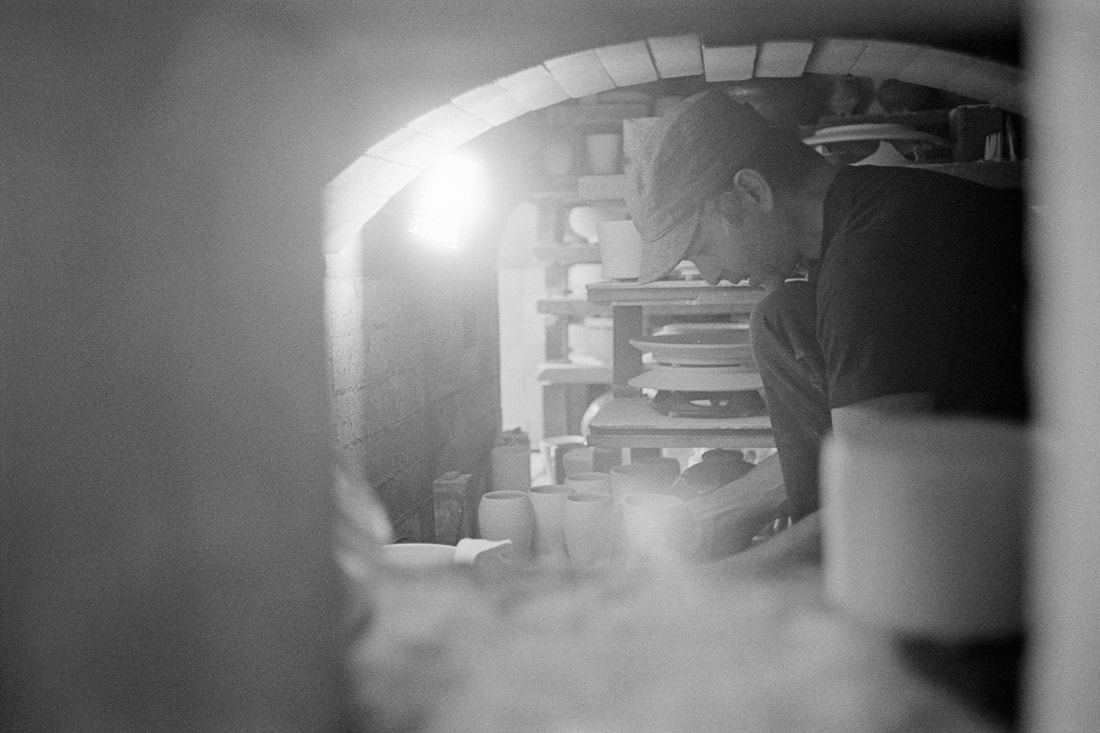The loading of a wood fired kiln is a meticulous process and often can be painstakingly slow. Each hand-crafted piece must first be tenderly delivered to the kiln compound from the studio, and carefully laid out on tables for sizing up. It is important that the weather cooperate, or at least that there be enough covered real estate so that the bisque-ware is kept dry. The work is then adorned with pea-sized refractory balls that are affixed to the bottom of each pot to keep them from sticking to the shelves during the firing. We call this refractory material wadding, and this important step is critical to the survival rate of each piece. An odd numbered configuration of wadding is often superior to an even-balled arrangement to achieve the most stable equilibrium. Decisions made around how to wad a pot can sometimes lead to spectacular disasters or alternatively, to unspoken victories that are only discovered after the firing is long since over and the kiln is cool enough to open. For the firing itself produces a net force so formidable that you want to be sure each piece remains as it was when it is loaded. The flame and heat, coupled with an insatiable draw from the chimney will produce a directional pull from the front to the rear of the kiln that is so intense, over a duration of days not hours. It’s often a wonder that there is a survival rate at all!
It is also important to prep the kiln furniture and shelves in advance. A light dusting off or puff of breath to break free any grit or cobwebs accumulated since the last firing is usually sufficient. Once that is done and the majority of work has been stilted, the actual loading may commence. The pots themselves will be called for by the loader, according to size and structure and the stack will arise slowly to fill the cubic feet available. A loaded kiln can be tight, dense, loose, balanced, voluminous, relaxed, even ample. And there are countless ways to stack; tall, open, low, even tumbled. The most important thing to remember with the load is not in the ‘how’ but in the ‘why’.
An experienced wood-firer will contemplate the load more passionately than the firing at times, knowingly placing each piece with intention in its rightful spot. It is only because through experience, a potter discovers that the flame path can actually be manipulated to suit his/her desires when it comes to surface development and aesthetics. At 1350 degrees Celsius, the flame moves through the kiln like a river, flowing in the direction of the draw, yearning for oxygen but finding holes and eddies to fill along its route. The flame behaves expectantly as it approaches the bodies of two forms tightly packed together, bouncing off the rounded belly of a pitcher or stretching long and thin to pass between two tall cylinders. Depositing ash and minerals from the wood onto the forms as it veers and skirts by. Rather, providing too much open space for the flame to move through the chamber forfeits nuance and all opportunity is lost to direct the fire in this manner.
A wood kiln must cool gently and deliberately before it can be unbricked to reveal which forms perished and which forms prevailed. Patience is necessary, and mustn’ts are real. No peeking or premature inspections, or else! But at least all the decision-making is complete and what will be, will be.
So while the loading of a wood kiln may take a little longer, and kneeling inside a cold kiln for hours on end in November may seem unendurable, each decision and detail made before the first match is lit can mean the difference between a failed lesson and a work of art.
It is also important to prep the kiln furniture and shelves in advance. A light dusting off or puff of breath to break free any grit or cobwebs accumulated since the last firing is usually sufficient. Once that is done and the majority of work has been stilted, the actual loading may commence. The pots themselves will be called for by the loader, according to size and structure and the stack will arise slowly to fill the cubic feet available. A loaded kiln can be tight, dense, loose, balanced, voluminous, relaxed, even ample. And there are countless ways to stack; tall, open, low, even tumbled. The most important thing to remember with the load is not in the ‘how’ but in the ‘why’.
An experienced wood-firer will contemplate the load more passionately than the firing at times, knowingly placing each piece with intention in its rightful spot. It is only because through experience, a potter discovers that the flame path can actually be manipulated to suit his/her desires when it comes to surface development and aesthetics. At 1350 degrees Celsius, the flame moves through the kiln like a river, flowing in the direction of the draw, yearning for oxygen but finding holes and eddies to fill along its route. The flame behaves expectantly as it approaches the bodies of two forms tightly packed together, bouncing off the rounded belly of a pitcher or stretching long and thin to pass between two tall cylinders. Depositing ash and minerals from the wood onto the forms as it veers and skirts by. Rather, providing too much open space for the flame to move through the chamber forfeits nuance and all opportunity is lost to direct the fire in this manner.
A wood kiln must cool gently and deliberately before it can be unbricked to reveal which forms perished and which forms prevailed. Patience is necessary, and mustn’ts are real. No peeking or premature inspections, or else! But at least all the decision-making is complete and what will be, will be.
So while the loading of a wood kiln may take a little longer, and kneeling inside a cold kiln for hours on end in November may seem unendurable, each decision and detail made before the first match is lit can mean the difference between a failed lesson and a work of art.


